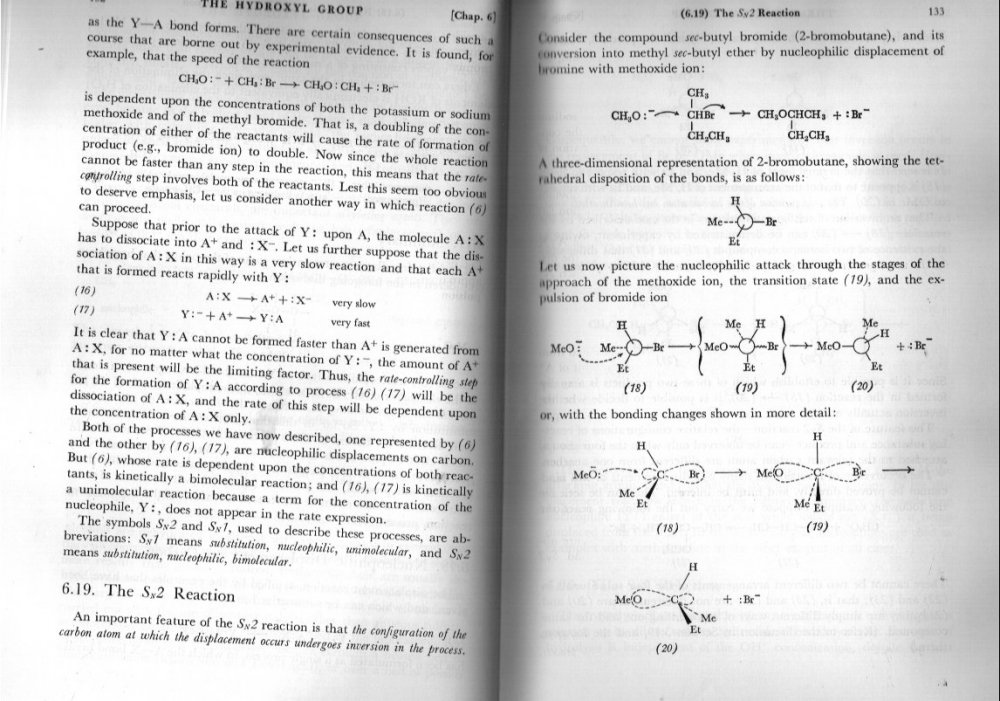-
Posts
18485 -
Joined
-
Last visited
-
Days Won
108
Everything posted by studiot
-
I think you have a choice. So how about concentrating more on those who are simply trying to help rather than contradict, as oppose to the other way round? Please let me know if I interpreted your idea correctly?
-

Does light propagate in a medium of any kind?
studiot replied to geordief's topic in Classical Physics
That is true. Sort of. Remember that two (or more) EM fields add together at every point to create only one resultant at that point. IOW there can be only one (resultant) value of the field at any point. So light itself (classically, not photons) 'carries' its own electric field wherever it goes. This means that there is no field at a point before (until) the light arrives there. So if it goes through empty space then that is all (the em field) there is. But if there is a preexisting field then the two fields add to form a 'disturbed' field where the light becomes a disturbance of the em field. Equally the disturbed field can be separated into 'components'. This is what an aerial does. Remember the way that the fields add can be quite complicated. -
Never done any pro gardening, but had some sort of garden most of my life. Coming from a rural area we had gardening classes in my primary school, 60 years ago. We actually tackled the project of carving out garden from wilderness. I'm really sorry this went out of fashion and the glorified plant boxes I see in some schools these days is not substitute. But I am convinced that gardens and their contents/design layout etc should have a purpose. So my current house faces due South and gets very (for UK) hot in the summer. Further the downstairs windows are pretty large. So I have two weeping deciduous trees dominating the front - a weeping silver birch and a weeping silver pear. In the summer they shade the front windows from the fiercest of the sun. In the winter they drop their leaves when the light levels are much lower and let more light in.
-
The title says most of it, here is an inspiring extract Four years ago, Brian and his fellow students at Makerere University in Kampala, Uganda, came up with this low-cost, reusable device called Matibabu which detects malaria quickly without drawing blood. Although still in prototype stage, the society judges called his malaria testing machine "simply a game changer" in the fight against this deadly disease. Magnets and matiscope "Matibabu" means "treatment" in Swahili, and the machine uses magnets and a custom-made portable device called a matiscope. This shines a red beam of light on to the user's finger, detecting a substance called haemozoin crystals, the by-products of the malaria parasite. The makers believe Matibabu could transform the situation by speeding up testing times since it does not need to draw blood nor use invasive needles that children, in particular, can struggle with. https://www.bbc.co.uk/news/business-44484581
-
Have you not appreciated Sensei's excellent point that for every mole of carbon dioxide you remove from the lake via lime, you release one to the atmosphere in the making of that lime?
-
Thank you for introducing an interesting topic. I found this reference dated 2015 https://psmag.com/environment/what-happens-if-lake-kivu-explodesObviously it hasn't happened yet. Does anyone know any more about it?
-
Did you ask a question? All a see is a short video, quite disconnected from the short paragraph that accompanied it, along with the claim that gravity is somehow involved. I see no proof or disproof of anything at all, nor any proper explanation of what is expected to happen and what does happen, along with a proposed explanation of why there is any difference between the two. I repeat, your paper should have moved when it was near/to the side of the pipe if gravity was involved. The paper didn't move so gravity was not involved. In the words of the Market Manager "Set out your stall properly"
-
Choose a dry season/time. Fencing in the wet is unpleasant. Gardeners are a friendly lot and like to show off the results of their labours. You can often get free seed/bedding plants and local advice. Maybe there is a local club, where you can get help with two handed jobs (like fencing). There's no perfect fence material. Wood in the ground, even in cement, eventually rots, steel eventually rusts and the ground may give way around either. Reconstituted plastic bags can be formed into fencing materials, but the look is always plastic, which some don't like. What do you want the fence to enclose?
-
I see no purpose to the pipe. It cannot possibly direct/focus gravity. Gravity is a 360 all round phenomenon. If the effect created had a gravitational component then it should be the same if the paper was dangled to the side of the tube.
-
Before anyone can explain an effect they have to have a proper knowledge of what happens. All I can see is the machine trying to jump around on the bench whilst you try to hold it down with one hand. In order to do this you will be concentrating on that restraining hand. You are holding piece of what looks like kitchen roll loose in the other hand, but this is a poor demonstration. The paper should be independently supported by a laboratory arm or frame. Then we could distinguish between judder in your arm and any other effect.
-
Perhaps you would like to enlighten me as to what I am supposted to be seeing in the video that has to do with gravity. At the moment I am completely baffled.
-
Let me wish you far greater success in your gardening thread (and gardening) than I had in my recent one, which received no replies.. As regards preparing a somewhat neglected patch for cultivation, don't expect too much too quickly. Yes you should most definitely dig over the proposed cultivated area before winter. I don't know if you have hard winters since you are a white bear, but frost action kills off many pests and breaks up large clods. You mentioned ploughing. Yes rotovating can relieve much of the work of digging. You don't need to achieve what is called a fine tilth before winter, just large clods will do. Cut back vegetation from around your area, and keep it cut back. Existing vegetation will harbour a source of pests next year otherwise. It will take 2 or 3 years to clean the csoil under cultivation of weed seed, roots and pest spores and grubs. So for the first couple of years you can expect lots of attacks on your plants. Birds help with the cleaning. Next sping turn the soil over and break down the remianing clods to a finer consistency (tilth) It is often said that potatoes are a good cleaning crop because the continual turning over of the soil promotes cleaning. Something to also consider is the cost of horticultural produce in your shops. Grow stuff which is expensive to buy, because anything that is 'in season for you' will also be in season for local commercial growers so will be at its cheapest then. For instance I grow soft fruit, particularly soft fruit, (strawberries, raspberries, gooseberries, blueberries etc). These are financially worthwhile. But tomatoes for instance are at rock bottom prices when mine would be ready, if I grew them. Capsicums and courgettes are a profitable crop too.
-
Yes I think you have are asking a very good question, +1, but unfortunately also arguing from extremes thus clouding the issue. Essentially you are observing (I think) that the curvature in GR in a given volume depends upon the matter particles present in that volume(as well as to a lesser extent those more remote). Thus if a particle that exists in one spacetime frame but doesn't in another doesn't that imply that curvature and therefore relativistic effects eg gravity are frame dependant? Please confirm my reading of your question or offer the correct one.
-
Excellent observation about independent existance. +1
-
I don't know what text you are using and not all textbooks bring out the differences btween Sn1 and Sn2. This extract from Geissman is particularly clear.
-

Wich is the best way to clean my desktop computer ?
studiot replied to bsmart805's topic in Computer Help
A layer of dust on components is a thermally insulating layer. Components are designed to operate in free air, insulating them will raise their tempeature and shorten their service life, resulting in premature failure. The important thing to do when blowing out fans is to immobilise the fan (eg with a screwdriver). Compressed air or even a vacuum cleaner can case excessively high rotation speed and the resultant back EMF can damage other parts of the circuit. Acetone attacks/dissolves the varnish on many components, (hence its use as nail varnish remover). It is also used as a perspex solvent/glue. -
Is that all you get for answering? Doesn't seem worth getting out of bed for.
-

Wich is the best way to clean my desktop computer ?
studiot replied to bsmart805's topic in Computer Help
Compressed air is better than a vacuum cleaner. Make sure ther is somewhere that doesn't matter for the dust bunnies to go outside or in a garage. -
Yes indeed there is at least one other choice. One or both particles may give off radiation which extends to the othr particle. Since there are only two (interacting) particles in your frame there is no observer in that frame. So we must look to some other frame to observe the interaction and this immediately brings in Relativity of simultaneity.
-
I use an old version of MathType, which is a commercial program to generate the Math. This allows me to type the maths in directly and copy / paste for the code in the webpage. I see no reason to learn yet another language/convention but prefer to expect the machine to do the work for me. Two free online alternatives are Sciweavers and Codecogs http://www.sciweavers.org/free-online-latex-equation-editor https://www.codecogs.com/latex/eqneditor.php
-
This is a valid conjecture and there is a recent Cambridge University book devoted to it, edited by a Professor of Mathematics from London University. Many august (pun intended) scientists have contributed. On Space and Time Shan Majid Cambridge University Press The current term used is not fragmented but granular. However time is continuous, in that there is nothing between the segments and all the segments 'line up' and abut each other, if they exist. This is unlike Quantum (energy) levels.
-
I'll second that and add a +1 for encouragement.
-
I was afraid of this so yes I will draw a sketch, but not till tomorrow as it's half past midnight here. You don't really need the torsion wire to consider what I am saying, that was an attempt to link the differential geometry of the isuue to the phyiscal implementation. You can have the meter on the floor, on the table, in the next room, facing North, South, East or West, upside down or whatever. Each of these will involve unique x, y z coordinate. Yet none of those x, y and z values will give you the reading on the meter; You need a fourth value -the angular deflection to specify that and this is therefore independent of the x,y,z coordinates.
-
I didn't mention the uncertainty principle. Are you afraid to do the simple calcs? Here is a simpler example. My car is 17 foot long and my garage 12 foot long. Could I close the door if I drove the car inside the garage?



